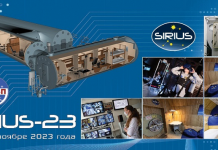Elon Musk showed a huge prototype of the super heavy accelerator Super Heavy
SpaceX has assembled the first Super Heavy stage of its Starship super-heavy launch vehicle in a hangar, effectively building the BN1 (Booster Number 1) prototype of the largest rocket booster ever built. Elon Musk announced this on his Twitter.

There is still a lot of work to weld the two main halves (liquid oxygen tank and methane tank) together, connecting the pre-installed piping and avionics. But these tasks are largely secondary – we can already speak of the BN1 design as a single steel tower. It consists of 36 rings, which are also used to assemble the Starship. The first Super Heavy BN1 prototype will have a height of about 67 meters from the top to the end of the Raptor engines’ nozzles, which will soon be installed.
Thus, the BN1 is only 3 meters lower than the two-stage Falcon 9 or Falcon Heavy – and this is the second and third tallest missiles in operation today. But it should be remembered that Super Heavy is just an accelerator. According to SpaceX, the entire rocket will have a height of at least 120 m (the Starship and Super Heavy spacecraft together). This will make the car the tallest (and probably the heaviest) launch vehicle ever.
It is noteworthy that Super Heavy BN1 does not even outwardly reflect the final accelerator that will participate in the first attempt at Starship’s orbital launch. SpaceX, for example, has given up installing any landing legs on the BN1. Elon Musk expressed a desire to avoid the need for such supports completely and capture super-heavy boosters (and possibly even Starship ships) using a ground tower with special giant manipulators. But it isn’t very likely that such a complex mechanism will be ready for full-scale testing of the BN1 this year.
SpaceX hopes to be able to launch Starship orbital launches as early as July 2021. Reportedly, the first attempt will involve the Super Heavy BN3 accelerator prototype and the Starship SN20 spacecraft. The BN1 is expected to stay on the ground, serving as a bench for the first pressure tests and other control tests, including engine burn-in.
If all goes according to plan, SpaceX will attempt at least one low jump with BN2, along with other tests. The number of Raptor engines will gradually increase until it reaches the design number of 28 units. The BN1 appears to be using only 4 engines.
It’s unclear when Super Heavy will go to the launchpad for tests, but it’s safe to say that it will happen after the Starship SN11 launch at 10 km – SpaceX hopes this time to do without explosions during or after landing. Elon Musk recently announced that the SN11 prototype is almost ready for launch.
Recall: according to Elon Musk, many changes were made to SN11 to correct the shortcomings identified during previous tests. He explained that the SN10 prototype exploded after landing because the engines ran out of power due to helium leaking from the fuel tank. On March 3, SpaceX launched its Starship SN10 spacecraft to an altitude of 10 kilometers and managed to land the car, although the rocket exploded a few minutes after landing. The mission followed two other Starship launches, SN9 and SN8, to the same altitude – the prototypes managed to take off and maneuver but crashed on landing. Here’s the official snapshot of the highlights from the latest SN10 launch:



